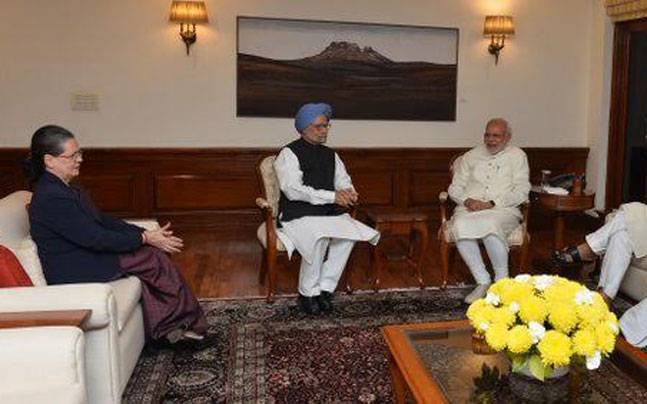Top Congress leaders Sonia Gandhi and Manmohan Singh today met Prime Minister Narendra Modi at his Race Course Road residence. On the second day of the Winter Session of Parliament came the thaw. The ice between the ruling coalition and the main Opposition, the Congress, broke after a long time when Prime Minister Narendra Modi invited Congress president Sonia Gandhi and former Prime Minister Manmohan Singh to the Prime Minister’s residence to discuss the Goods and Services Tax. Even before the meeting, the Prime Minister struck a reconciliatory note in his speech in Lok Sabha by calling for consensus on issues of national interest.
The government, often accused of being unilateral in decisions because it enjoys majority in the Lower House, has put the GST legislation on fast track. It is clear that the government wants to get done with this GST business as soon as possible and hopes to implement it by the next financial year. Based on the experience of countries where GST isalready in action, the government knows the implementation of GST generally will lead to an initial backlash as things are bound to get slightly expensive with the new levy. The sooner the better. The government doesn’t want it to hang fire and singe it in a big election year. The meeting between the leading lights of the government and the opposition saw the two parties discussing other issues as well. In the major reach-out to the main Opposition, the Prime Minister invited Gandhi and Singh over tea at his Race Course Road residence around 7 PM.
“Former PM Dr. Manmohan Singh & Congress President Smt. Sonia Gandhi meet PM. Top ministers are present at the meet,” the PMO said in a tweet. &; PIB India (@PIB_India) November 27, 2015 Finance Minister Arun Jaitley and Parliamentary Affairs Minister M. Venkaiah Naidu were also present at the meeting. “Former PM Dr. Manmohan Singh & Congress President Smt.Sonia Gandhi meet PM. Top ministers are present at the meet,” the PMO said in a tweet. The meeting lasted about 45 minutes. Jaitley had told the media yesterday that Modi was willing to speak to everyone to get the tax law through. Jaitley, who needs Parliament approval for the GST Bill in the Winter Session to roll out the new indirect tax regime as scheduled from April 1, had said he has spoken to “almost all Congress leaders” on the issue. “We have absolutely no hesitation even at the level of the Prime Minister. We have never had in it in the past, we don’t have it (now). He is willing to speak to everyone,” he had said. Congress had stalled passage of the GST Constitution Amendment Bill in the last session of Parliament over its demand that a revenue-neutral rate not higher than 18 per cent be mentioned in it.
It is also opposed to states being given powers to levy additional 1 per cent tax on supply of goods over and above GST rate. GST Logjam Congress’ three demands 1. GST rate capped at 18 per cent 2. No taxation on interstate sales 3. Tax dispute to be resolved through mechanism Government’s response to the 3 demands 1. Will be difficult to alter the rate in future 2.Tax to reimburse high producing states 3. Not clear on the mechanism What’s the GST Bill 1. The Goods and Services Tax (GST) is billed as India’s biggest tax reform since Independence. 2. GST is a single tax on any supply of goods or services and would replace excise, service tax, state Value Added Tax, entry tax and other state levies. 3. VAT regulations and rates generally vary across states but GST would introduce uniform taxation laws across states and different sectors. 4. The taxes would be divided between the state and the Centre, based on a formula that would be acceptable to both. 5. GST Bill will reduces the tax burden on producers. 6. GST will lower overall production cost and increase the output of the economy in the long run. 7. Initially however, GST is likely tocause high inflation rates, administrative costs, and face stiff opposition from states due to loss of autonomy.








